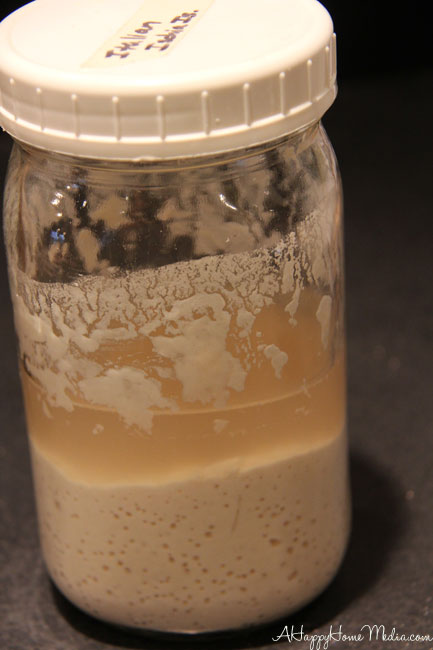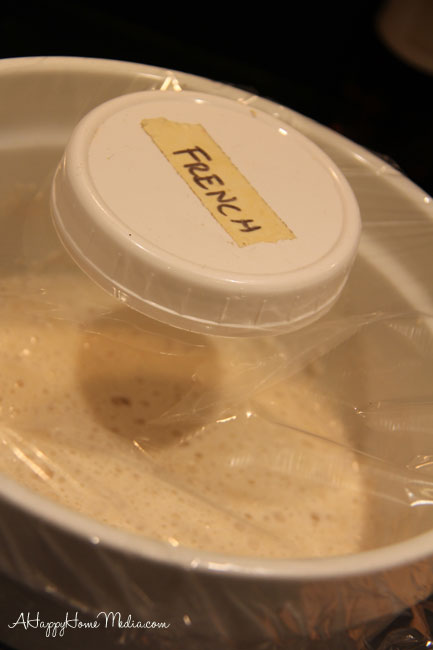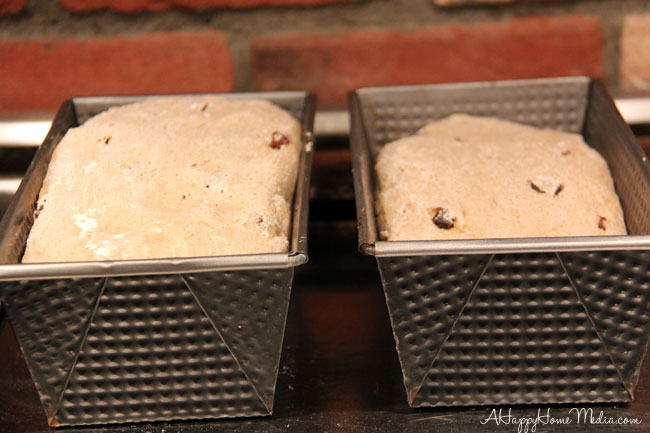I’ve been feeling the need to update my post on whole wheat sourdough bread, mainly because baking with sourdough is far, far easier than the recipe I left there. And now that I’ve been at it for several years, I’ve also gotten to a nice rotation in juggling multiple sourdough starters. I get most of my starters from Sourdoughs International, and I’ve been very pleased. Each one has a different personality, a different flavor, and even a different scent! Some work really well with heavy whole wheat (such as the Russian or Polish Rye), and others work better for white or wheat/white mixed breads (such as the French or Italian). Some ferment and rise very quickly, within a few hours, and some take all day.
I realize that *real* bakers weigh their ingredients, but I’ve really enjoyed just following the recipes in Classic Sourdoughs (also available via Amazon). Furthermore, I really like just eyeballing the flour and water mixture for consistency, and I learned that through the book, too. I almost never use baker’s yeast anymore at all, and when I do, it’s always kind of a bummer I didn’t have my starter ready.
I keep all of my starters in the fridge. I’ve kept and rotated four at a time for a while, but I got kind of bored and dehydrated a couple. After a nice long baking sabbatical, I added a Polish Rye to the group, and currently I am keeping and rotating three (one Italian and a French, along with the Rye). At the ready for rehydrating when I’d like are a Russian, another Italian, an Alaskan and a South African. I love having so much variety in my baked goods at home! The nutritional value AND the money savings are bonus!
This is how I rotate my starters; all of these pictures were taken on one single morning.
When I remove a starter from the fridge, it looks like this. It’s probably been a week or two since I’ve used this starter. The separation is normal. I will pour this entire jar into a ceramic bowl, and then “feed” it with some flour and water. I eyeball both measurements, taking care to keep my flour just less than half of how much starter there is, and then slowly whisking in water until I get that pancake consistency. I love using my Danish dough whisk for this, but I did use a large fork for a long time. I cover the bowl and put it aside. I’ll be feeding it again in the evening (second feeding) and a third time the following morning. That following evening is when I will put a dough of something together, to let it rise overnight.

This is a bowl of starter I had begun the day before. All I have to do here is feed it, again just eyeballing it and let it sit until evening. If I forget or choose not to make dough that evening, I simply hold it over until morning for pancakes or waffles or pizza dough or even chocolate cake. YUM. And I really, really, really try not to forget to SAVE STARTER BEFORE MIXING DOUGH. The saved starter (back into a fresh mason jar) gets a little feed and goes back into the fridge until its turn to play is again up.
By the way, the best way to not lose starter is to share with friends 😉
Lastly, I have a bowl of dough mixed from the night before, risen and ready to be scraped out onto the counter to rest for a half hour. Then I put my dough into loaf pans and let it rise until its good and ready to throw into the oven. Depending on the starter, this could be just 2 hours, or 8-10! This happened to be my Polish Rye (a slow riser), and I made a couple of loaves of whole wheat raisin bread. I baked them that afternoon and we had seriously crazy yummo sourdough rye raisin bread to toast for our breakfast the next morning.
I suppose the last photo ought to be the finished bread, crumbs and melted butter on a sweet plate dappled by sunlight. But we ate it all before I bothered to take any photos that would make you drool 🙂
I don’t really plan ahead what I’m going to bake. Typically, I just pull out the next starter and consider what kind of breads would be good with that one. Sometimes I just don’t bake anything at all for days. And when I do bake, it’s in small batches. Gone are my days of pulling out half a dozen yeast breads at a time. Sourdough breads are not only delicious, but they are far more filling.
Juggling multiple sourdough starters isn’t really difficult. It’s just like anything else, simply a learning curve to get around.
Blessings,




Great info! I’ve been trying to get up the nerve to try sourdough for quite a while, at least a year. Have you ever made your own starter?
Hi Amy
I would encourage you to give sourdough a try! It’s very forgiving. I haven’t had the desire to make my own starter so haven’t tried. I like using starters from all over the world 🙂
So, you can safely put lids over your sourdoughs in the fridge and they never blow up? They don’t need to breathe? Mine are not volatile except for the first 12-24 hours after feeding, but I was just thinking of ways to prevent mold. Putting lids on would be wonderful. Please let me know. I have an einkorn, whole wheat, and a rye starter/
Also, do you scree it down all the way or just lightly? Thanks.
Hello Amy
I have never had a starter blow up in the fridge, even after many, many months of dormancy. I use the plastic screw on lids, and I just tighten them lightly. Happy baking 🙂